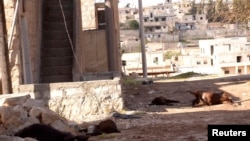UNITED NATIONS —
The U.N. mission tasked with assessing whether chemical weapons have been used in the Syrian conflict has concluded in its final report that they were used.
The findings of mission leader Ake Sellstrom’s report do not come as a surprise. But the scientist and his team were in the midst of investigating several allegations when the August 21 attack in the Ghouta area of Damascus killed more than 1,000 people and diverted their attention.
Sellstrom and his team returned to Syria and stayed from September 25 to the 29th to look into other allegations. The Swedish scientist presented the mission’s final report to U.N. Secretary-General Ban Ki-moon on Thursday.
Ban noted that much has happened since the first allegations of chemical weapons use in March.
“The Syrian government acknowledged that it possessed chemical weapons and subsequently joined the Chemical Weapons Convention. An OPCW-U.N. Joint Mission was established and continues to oversee the timely elimination of Syria’s chemical weapons program in the safest and most secure manner possible," said Ban.
While the Sellstrom report concludes that poison gas was likely used in five of seven cases, including the August 21 Ghouta attack, the mission’s mandate was not to determine who used it.
The mission interviewed patients and medical personnel and took blood and DNA samples, as well as samples from at least one cadaver. Team members appear to have visited only the Ghouta and Jobar sites, both in the Damascus area.
The report concludes that chemical weapons likely were used in Ghouta, Khan al Asal, Jobar, Saraqueb and Ashrafiah Sahnaya, but not in Sheik Maqsood or Bahhariyeh.
It states it did not receive sufficient or credible information regarding nine other alleged poison gas incidents.
The U.N. chief said he will privately brief the General Assembly on the Sellstrom report Friday and the Security Council on Monday.
The findings of mission leader Ake Sellstrom’s report do not come as a surprise. But the scientist and his team were in the midst of investigating several allegations when the August 21 attack in the Ghouta area of Damascus killed more than 1,000 people and diverted their attention.
Sellstrom and his team returned to Syria and stayed from September 25 to the 29th to look into other allegations. The Swedish scientist presented the mission’s final report to U.N. Secretary-General Ban Ki-moon on Thursday.
Ban noted that much has happened since the first allegations of chemical weapons use in March.
“The Syrian government acknowledged that it possessed chemical weapons and subsequently joined the Chemical Weapons Convention. An OPCW-U.N. Joint Mission was established and continues to oversee the timely elimination of Syria’s chemical weapons program in the safest and most secure manner possible," said Ban.
While the Sellstrom report concludes that poison gas was likely used in five of seven cases, including the August 21 Ghouta attack, the mission’s mandate was not to determine who used it.
The mission interviewed patients and medical personnel and took blood and DNA samples, as well as samples from at least one cadaver. Team members appear to have visited only the Ghouta and Jobar sites, both in the Damascus area.
The report concludes that chemical weapons likely were used in Ghouta, Khan al Asal, Jobar, Saraqueb and Ashrafiah Sahnaya, but not in Sheik Maqsood or Bahhariyeh.
It states it did not receive sufficient or credible information regarding nine other alleged poison gas incidents.
The U.N. chief said he will privately brief the General Assembly on the Sellstrom report Friday and the Security Council on Monday.








